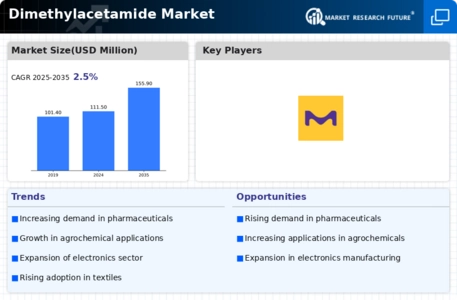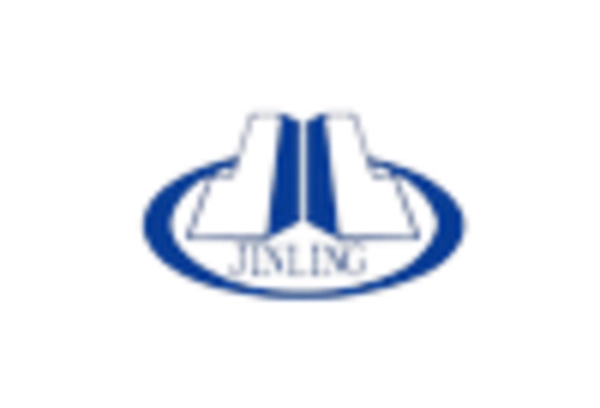-
Executive Summary
-
Market Introduction
-
Market Definition
-
Scope of the
- Research
- Assumptions & Limitations
-
Study
-
Objectives
-
Markets Structure
-
Key Takeaways
-
Market Research Methodology
-
Research Process
-
Primary Research
-
Secondary Research
-
Market Size Estimation
-
Forecast Model
-
Market Dynamics of the Global Dimethylacetamide
-
Market
-
Introduction
-
Drivers
-
Restraints
-
Opportunities
-
Challenges
-
Trends/Technology
-
Market Factor Analysis of the Global Dimethylacetamide
-
Market
-
Supply Chain Analysis
- Raw Material Suppliers
- Distributors/Retailers/Wholesalers/E-Commerce
- End User
- Bargaining
- Bargaining Power
- Threat of Substitutes
- Intensity of Competitive Rivalry
-
Manufacturers/Producers
-
Porter’s Five Forces Analysis
-
Threat of New Entrants
-
Power of Buyers
-
of Suppliers
-
Pricing Analysis
-
Global Dimethylacetamide Market,
-
by Application
-
Introduction
-
Acrylic
- Market Estimates
- Market Estimates & Forecast,
-
Fiber
-
& Forecast, 2020−2027
-
by Region, 2020−2027
-
Pesticides
- Market Estimates & Forecast,
- Market Estimates & Forecast, by Region, 2020−2027
-
Synthetic Resins
- Market Estimates & Forecast, 2020−2027
-
Market Estimates & Forecast, by Region, 2020−2027
-
Intermediates
-
Market Estimates & Forecast, 2020−2027
-
& Forecast, by Region, 2020−2027
-
& Forecast, 2020−2027
-
by Region, 2020−2027
-
Market Estimates
-
Others
- Market Estimates
- Market Estimates & Forecast,
-
Global Dimethylacetamide Market,
-
by End-Use Industry
-
Introduction
- Market Estimates & Forecast, 2020−2027
- Market Estimates & Forecast, by Region, 2020−2027
- Market Estimates & Forecast, 2020−2027
- Market Estimates & Forecast, by Region, 2020−2027
- Market Estimates & Forecast, 2020−2027
- Market Estimates & Forecast, by Region, 2020−2027
- Market Estimates & Forecast, 2020−2027
- Market Estimates & Forecast, by Region, 2020−2027
- Market Estimates & Forecast, 2020−2027
- Market Estimates & Forecast, by Region, 2020−2027
- Market Estimates & Forecast, 2020−2027
- Market Estimates & Forecast, by Region, 2020−2027
- Market Estimates & Forecast, 2020−2027
- Market Estimates & Forecast, by Region, 2020−2027
- Market Estimates & Forecast, 2020−2027
- Market Estimates & Forecast, by Region, 2020−2027
-
Pharmaceutical
-
Agrochemical
-
Textile
-
Plastics
-
Personal Care
-
Others
-
Finishing Agents
-
Others
-
Global Dimethylacetamide Market, by Region
-
Introduction
-
North America
- Market Estimates &
- Market Estimates & Forecast,
- Market Estimates & Forecast,
- US
-
Forecast, 2020−2027
-
by Application, 2020−2027
-
by End-Use Industry, 2020−2027
-
Market Estimates & Forecast, by Application, 2020−2027
-
End-Use Industry, 2020−2027
-
Market Estimates & Forecast,
-
Canada
-
Market Estimates & Forecast,
-
Market Estimates & Forecast, by Application, 2020−2027
-
by End-Use Industry, 2020−2027
-
Market Estimates & Forecast, 2020−2027
-
Market Estimates & Forecast,
-
Europe
-
Market Estimates & Forecast, by Application, 2020−2027
-
Market Estimates & Forecast, by End-Use Industry, 2020−2027
-
Forecast, by Application, 2020−2027
-
& Forecast, by Application, 2020−2027
-
Industry, 2020−2027
-
Germany
-
Market Estimates & Forecast, 2020−2027
-
Market Estimates &
-
Market Estimates & Forecast, by End-Use Industry,
-
France
-
Market Estimates & Forecast, 2020−2027
-
Market Estimates
-
Market Estimates & Forecast, by End-Use
-
Italy
-
Market Estimates & Forecast,
-
Market Estimates & Forecast, by Application, 2020−2027
-
by End-Use Industry, 2020−2027
-
Forecast, 2020−2027
-
& Forecast, by End-Use Industry, 2020−2027
-
UK
-
& Forecast, 2020−2027
-
& Forecast, by End-Use Industry, 2020−2027
-
Russia
-
Estimates & Forecast, 2020−2027
-
& Forecast, by End-Use Industry, 2020−2027
-
& Forecast, 2020−2027
-
& Forecast, by End-Use Industry, 2020−2027
-
of Europe
-
Market Estimates & Forecast, 2020−2027
-
Market Estimates & Forecast,
-
Spain
-
Market Estimates &
-
Market Estimates & Forecast, by Application,2020−2027
-
Market Estimates
-
Market Estimates
-
Market Estimates & Forecast, by Application,2020−2027
-
Market Estimates
-
Market
-
Market Estimates & Forecast, by Application,2020−2027
-
Market Estimates
-
Poland
-
Market Estimates
-
Market Estimates & Forecast, by Application, 2020−2027
-
Market Estimates
-
Rest
-
Market Estimates & Forecast, by Application,
-
Market Estimates & Forecast, by End-Use Industry, 2020−2027
-
Asia-Pacific
- Market Estimates &
- Market Estimates & Forecast,
- Market Estimates & Forecast,
- China
- Japan
- Australia &
- Rest of Asia-Pacific
- Market Estimates &
- Market Estimates & Forecast,
- Market Estimates & Forecast,
- GCC
-
Forecast, 2020−2027
-
by Application, 2020−2027
-
by End-Use Industry, 2020−2027
-
& Forecast, 2020−2027
-
& Forecast, by End-Use Industry, 2020−2027
-
India
-
Market Estimates & Forecast, 2020−2027
-
by Application, 2020−2027
-
& Forecast, by Application, 2020−2027
-
Industry, 2020−2027
-
New Zealand
-
Market Estimates & Forecast, 2020−2027
-
by Application, 2020−2027
-
& Forecast, by Application, 2020−2027
-
Industry, 2020−2027
-
Middle East & Africa
-
Forecast, 2020−2027
-
by Application, 2020−2027
-
by End-Use Industry, 2020−2027
-
Market Estimates & Forecast, by Application, 2020−2027
-
by End-Use Industry, 2020−2027
-
Forecast, 2020−2027
-
& Forecast, by End-Use Industry, 2020−2027
-
North Africa
-
Market Estimates & Forecast, 2020−2027
-
Market Estimates & Forecast,
-
Israel
-
Market Estimates &
-
Market Estimates & Forecast, by Application, 2020−2027
-
Market Estimates
-
Market Estimates & Forecast, by Application,
-
Market Estimates & Forecast, by End-Use Industry, 2020−2027
-
by Application, 2020−2027
-
& Forecast, by Application, 2020−2027
-
Industry, 2020−2027
-
Market Estimates & Forecast, 2020−2027
-
Turkey
-
Market Estimates & Forecast, 2020−2027
-
Market Estimates & Forecast,
-
Market Estimates & Forecast, by End-Use Industry, 2020−2027
-
Rest of Middle East & Africa
-
Market Estimates & Forecast, 2020−2027
-
Market Estimates
-
Market Estimates & Forecast, by End-Use
-
Latin America
-
Market Estimates & Forecast, by Application, 2020−2027
-
Market Estimates & Forecast, by End-Use Industry, 2020−2027
-
Forecast, by Application, 2020−2027
-
Brazil
-
Market Estimates & Forecast, 2020−2027
-
Market Estimates &
-
Market Estimates & Forecast, by End-Use Industry,
-
Argentina
-
Market Estimates & Forecast,
-
Market Estimates & Forecast, by Application, 2020−2027
-
by End-Use Industry, 2020−2027
-
& Forecast, 2020−2027
-
& Forecast, by End-Use Industry, 2020−2027
-
Rest of Latin America
-
by Application, 2020−2027
-
Market Estimates & Forecast,
-
Mexico
-
Market Estimates
-
Market Estimates & Forecast, by Application, 2020−2027
-
Market Estimates
-
Market Estimates & Forecast, 2020−2027
-
Market Estimates & Forecast,
-
Market Estimates & Forecast, by End-Use Industry, 2020−2027
-
Company Landscape
-
Introduction
-
Market Strategies
-
Key Development Analysis (Expansion/Merger & Acquisitions/Joint
-
Venture/New Product Development/Agreement/Investment)
-
Company Profiles
-
BASF SE
- Financial Updates
- Product/Business Segment Overview
- Key Strategies
- SWOT Analysis
-
Company Overview
-
Key Developments
-
DuPont
- Company
- Financial Updates
- Product/Business Segment Overview
- Key Developments
- SWOT Analysis
-
Overview
-
Key Strategies
-
Ak-kim
- Financial Updates
- Product/Business Segment Overview
- Key Strategies
- SWOT Analysis
-
Kimya
-
Company Overview
-
Key Developments
-
Samsung Fine Chemicals Co., Ltd
- Company Overview
- Financial Updates
- Key Developments
- SWOT Analysis
-
Product/Business Segment Overview
-
Key Strategies
-
MITSUBISHI
- Financial Updates
- Product/Business Segment Overview
- Key Strategies
- SWOT Analysis
-
GAS CHEMICAL COMPANY, INC.
-
Company Overview
-
Key Developments
-
Holy Stone Enterprise Co., Ltd
- Financial Updates
- Product/Business Segment Overview
- Key Strategies
- SWOT Analysis
-
Company Overview
-
Key Developments
-
Merck KGaA
- Company
- Financial Updates
- Product/Business Segment Overview
- Key Developments
- SWOT Analysis
-
Overview
-
Key Strategies
-
Conclusion
-
LIST OF TABLES
-
Table 1
-
Global Dimethylacetamide Market, by Region, 2020−2027
-
Table 2
-
North America: Dimethylacetamide Market, by Country, 2020−2027
-
Table
-
Europe: Dimethylacetamide Market, by Country, 2020−2027
-
Asia-Pacific: Dimethylacetamide Market, by Country,
-
Middle East & Africa: Dimethylacetamide
-
Market, by Country, 2020−2027
-
Latin America:
-
Dimethylacetamide Market, by Country, 2020−2027
-
Global
-
Dimethylacetamide Application Market, by Regions, 2020−2027
-
Table 8
-
North America: Dimethylacetamide Application Market, by Country, 2020−2027
-
Europe: Dimethylacetamide Application Market, by Country,
-
Table10 Asia-Pacific: Dimethylacetamide Application
-
Market, by Country, 2020−2027
-
Table11 Middle East &
-
Africa: Dimethylacetamide Application Market, by Country, 2020−2027
-
Table12
-
Latin America: Dimethylacetamide Application Market, by Country, 2020−2027
-
Table13 Global Dimethylacetamide End-Use Industry Market, by
-
Regions, 2020−2027
-
Table14 North America: Dimethylacetamide
-
End-Use Industry Market, by Country, 2020−2027
-
Table15 Europe:
-
Dimethylacetamide End-Use Industry Market, by Country, 2020−2027
-
Table16
-
Asia-Pacific: Dimethylacetamide End-Use Industry Market, by Country, 2020−2027
-
Table17 Middle East & Africa: Dimethylacetamide End-Use
-
Industry Market, by Country, 2020−2027
-
Table18 Latin
-
America: Dimethylacetamide by End-Use Industry Market, by Country, 2020-2023
-
Table19 Global Application Market, by Region, 2020−2027
-
Table20 Global End-Use Industry Market, by Region, 2020−2027
-
Table21 North America: Dimethylacetamide Market, by Country,
-
Table22 North America: Dimethylacetamide
-
Market, by Application, 2020−2027
-
Table23 North America:
-
Dimethylacetamide Market, by End-Use Industry, 2020−2027
-
Table24
-
Europe: Dimethylacetamide Market, by Country, 2020−2027
-
Table25
-
Europe: Dimethylacetamide Market, by Application, 2020−2027
-
Table26 Europe: Dimethylacetamide Market, by End-Use Industry,
-
Table27 Asia-Pacific: Dimethylacetamide
-
Market, by Country, 2020−2027
-
Table28 Asia-Pacific:
-
Dimethylacetamide Market, by Application, 2020−2027
-
Table29
-
Asia-Pacific: Dimethylacetamide Market, by End-Use Industry, 2020−2027
-
Table30 Middle East & Africa: Dimethylacetamide
-
Market, by Country, 2020−2027
-
Table31 Middle East &
-
Africa: Dimethylacetamide Market, by Application, 2020−2027
-
Table32
-
Middle East & Africa: Dimethylacetamide Market, by End-Use Industry, 2020−2027
-
Table33 Latin America: Dimethylacetamide Market, by Country,
-
Table34 Latin America: Dimethylacetamide
-
Market, by Application, 2020−2027
-
Table35 Latin America:
-
Dimethylacetamide Market, by End-Use Industry, 2020−2027
-
LIST
-
OF FIGURES
-
Global Dimethylacetamide Market Segmentation
-
Forecast Research Methodology
-
FIGURE 3
-
Five Forces Analysis of the Global Dimethylacetamide Market
-
FIGURE 4
-
Value Chain of the Global Dimethylacetamide Market
-
FIGURE 5
-
Global Dimethylacetamide Market, 2020−2027, by Country, 2020
-
FIGURE 6
-
Share of the Global Dimethylacetamide Market, by Application, 2020−2027
-
Global Dimethylacetamide Market Size, by Application, 2020
-
Share of the Global Dimethylacetamide Market, by Application,
-
Global Dimethylacetamide Market Size,
-
by End-Use Industry, 2020
-
FIGURE10 Share of the Global Dimethylacetamide
-
Market, by End-Use Industry, 2020−2027

















Leave a Comment